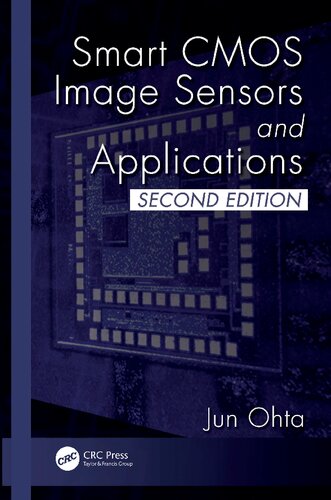

Most ebook files are in PDF format, so you can easily read them using various software such as Foxit Reader or directly on the Google Chrome browser.
Some ebook files are released by publishers in other formats such as .awz, .mobi, .epub, .fb2, etc. You may need to install specific software to read these formats on mobile/PC, such as Calibre.
Please read the tutorial at this link. https://ebooknice.com/page/post?id=faq
We offer FREE conversion to the popular formats you request; however, this may take some time. Therefore, right after payment, please email us, and we will try to provide the service as quickly as possible.
For some exceptional file formats or broken links (if any), please refrain from opening any disputes. Instead, email us first, and we will try to assist within a maximum of 6 hours.
EbookNice Team

Status:
Available4.4
7 reviews
ISBN 10: 1498764649
ISBN 13: 978-1498764643
Author: Jun Ohta
Revised and expanded for this new edition, Smart CMOS Image Sensors and Applications, Second Edition is the only book available devoted to smart CMOS image sensors and applications. The book describes the fundamentals of CMOS image sensors and optoelectronic device physics, and introduces typical CMOS image sensor structures, such as the active pixel sensor (APS). Also included are the functions and materials of smart CMOS image sensors and present examples of smart imaging. Various applications of smart CMOS image sensors are also discussed. Several appendices supply a range of information on constants, illuminance, MOSFET characteristics, and optical resolution. Expansion of smart materials, smart imaging and applications, including biotechnology and optical wireless communication, are included.
Features
• Covers the fundamentals and applications including smart materials, smart imaging, and various applications
• Includes comprehensive references
• Discusses a wide variety of applications of smart CMOS image sensors including biotechnology and optical wireless communication
• Revised and expanded to include the state of the art of smart image sensors
1.1 A general overview
1.2 Brief history of CMOS image sensors
1.3 Brief history of smart CMOS image sensors
1.4 Organization of the book
2.1 Introduction
2.2 Fundamentals of photo detection
2.2.1 Absorption coefficient
2.2.2 Behavior of minority carriers
2.2.3 Sensitivity and quantum efficiency
2.3 Photodetectors for smart CMOS image sensors
2.3.1 pn-junction photodiode
2.3.2 Photogate
2.3.3 Phototransistor
2.3.4 Avalanche photodiode
2.3.5 Photoconductive detector
2.4 Accumulation mode in PDs
2.4.1 Potential change in accumulation mode
2.4.2 Potential description
2.4.3 Behavior of photo-generated carriers in PD
2.5 Basic pixel structures
2.5.1 Passive pixel sensor
2.5.2 Active pixel sensor, 3T-APS
2.5.3 Active pixel sensor, 4T-APS
2.6 Sensor peripherals
2.6.1 Addressing
2.6.2 Readout circuits
2.6.3 Analog-to-digital converters
2.7 Basic sensor characteristics
2.7.1 Noise
2.7.2 Dynamic range
2.7.3 Speed
2.8 Color
2.9 Pixel sharing
2.10 Comparison between pixel architecture
2.11 Comparison with CCDs
3.1 Introduction
3.2 Pixel structure
3.2.1 Current mode
3.2.2 Log sensor
3.3 Analog operation
3.3.1 Winner-take-all
3.3.2 Projection
3.3.3 Resistive network
3.4 Pulse modulation
3.4.1 Pulse width modulation
3.4.2 Pulse frequency modulation
3.5 Digital processing
3.6 Materials other than silicon
3.6.1 Silicon-on-insulator
3.6.2 Extending the detection wavelength
3.7 Structures other than standard CMOS technologies
3.7.1 3D integration
3.7.2 Integration with light emitters
3.7.3 Color realization using nonstandard structures
4.1 Introduction
4.2 Low light imaging
4.2.2 PFM for lowlight imaging
4.2.3 Differential APS
4.2.4 Geiger mode APD for a smart CMOS image sensor
4.3 High speed
4.3.1 Global shutter
4.4 Wide dynamic range
4.4.1 Principle of wide dynamic range
4.4.2 Dual sensitivity
4.4.3 Nonlinear response
4.4.4 Multiple sampling
4.4.5 Saturation detection
4.4.6 Diffusive brightness
4.5 Demodulation
4.5.1 Principles of demodulation
4.5.2 Correlation
4.5.3 Method of two accumulation regions
4.6 Three-dimensional rangefinder
4.6.1 Time of flight
4.6.2 Triangulation
4.6.3 Depth key
4.7 Target tracking
4.7.1 Maximum detection for target tracking
4.7.2 Projection for target tracking
4.7.3 Resistive network and other analog processing for target tracking
4.7.4 Digital processing for target tracking
4.8 Dedicated arrangement of pixel and optics
4.8.1 Non-orthogonal arrangement
4.8.2 Dedicated optics
4.8.3 Light field detection
4.9 Polarization detection
5.1 Introduction
5.2 Information and communication applications
5.2.1 Optical ID tag
5.2.2 Optical wireless communication
5.3 Biotechnology applications
5.3.1 Smart CMOS image sensor with multi-modal functions
5.3.2 Smart CMOS image sensor with ISFET
5.3.3 Potential imaging combining MEMS technology
5.3.4 Smart CMOS sensor for optical and electrochemical imaging
5.3.5 Fluorescence detection
5.4 Medical applications
5.4.1 Capsule endoscope
5.4.2 Retinal prosthesis
A. Tables of constants
B. Illuminance
C. Human eye and CMOS image sensors
D. Fundamental characteristics of MOS capacitors
E. Fundamental characteristics of MOSFET
F. Optical format and resolution
smart cmos image sensors and applications pdf
how does a cmos image sensor work
cmos digital image sensor
how does cmos image sensor work
Tags: Jun Ohta, Smart CMOS Image, Sensors and Applications